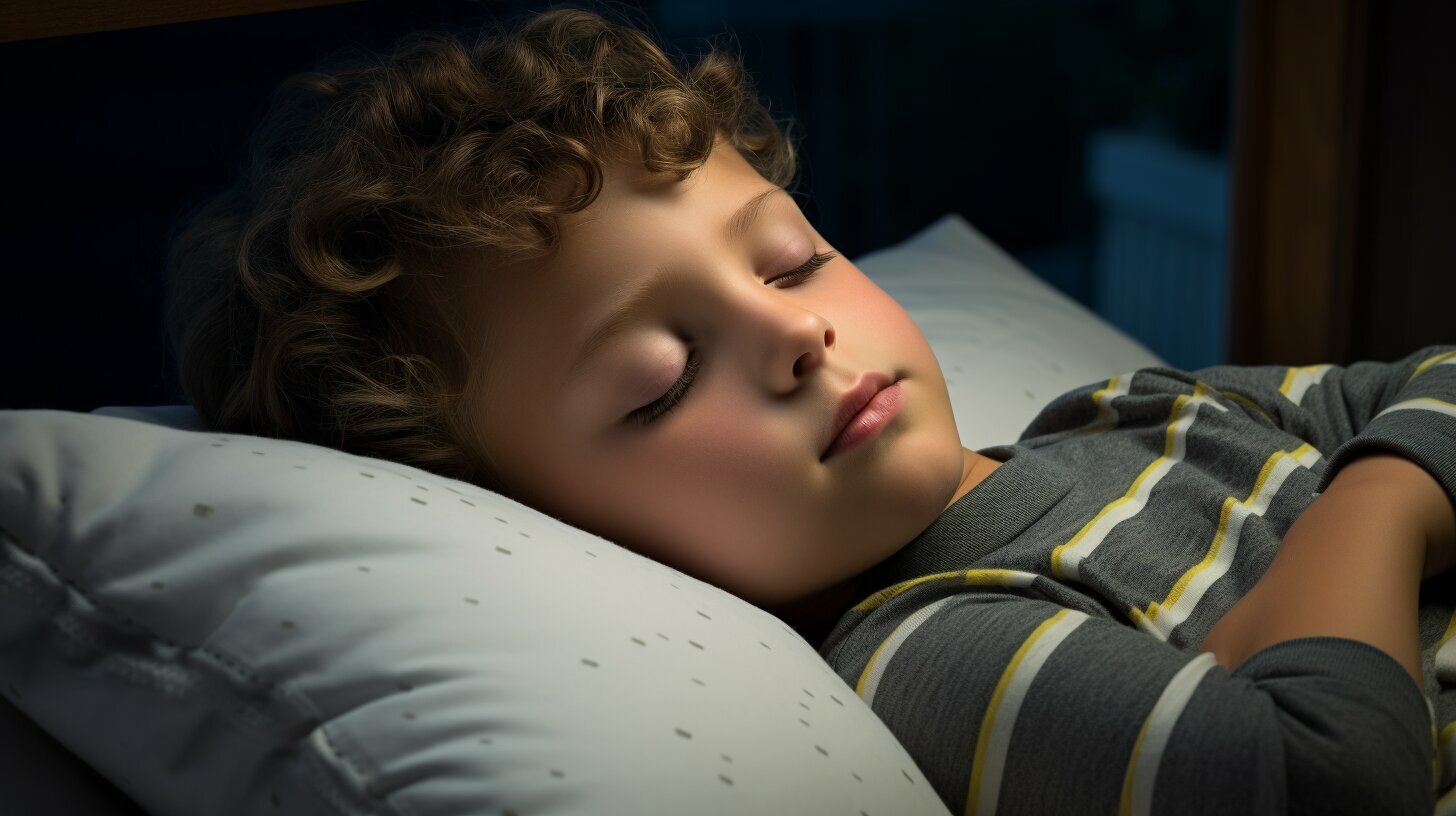Sleep safety is a crucial consideration for parents, and knowing when should a child sleep with a pillow is an important aspect of creating a safe sleep environment for them.
It’s essential to strike the right balance between comfort and safety to ensure your little one a restful night’s sleep.
Some Important Points For You To Consider:
- The NHS recommends waiting until a child is 12 months old before introducing a pillow.
- Some experts suggest waiting until the child is 18 months to 2 years old to ensure their safety.
- Pillows should only be introduced when a child has transitioned from a cot to a toddler bed, usually around 18 months to 2 years of age.
- Using adult-sized pillows can pose a suffocation risk, so it’s important to choose a toddler pillow that is thin, firm, and small in size.
- Safety should always be the top priority, and if the child and parent are comfortable without a pillow, there is no rush to introduce one.
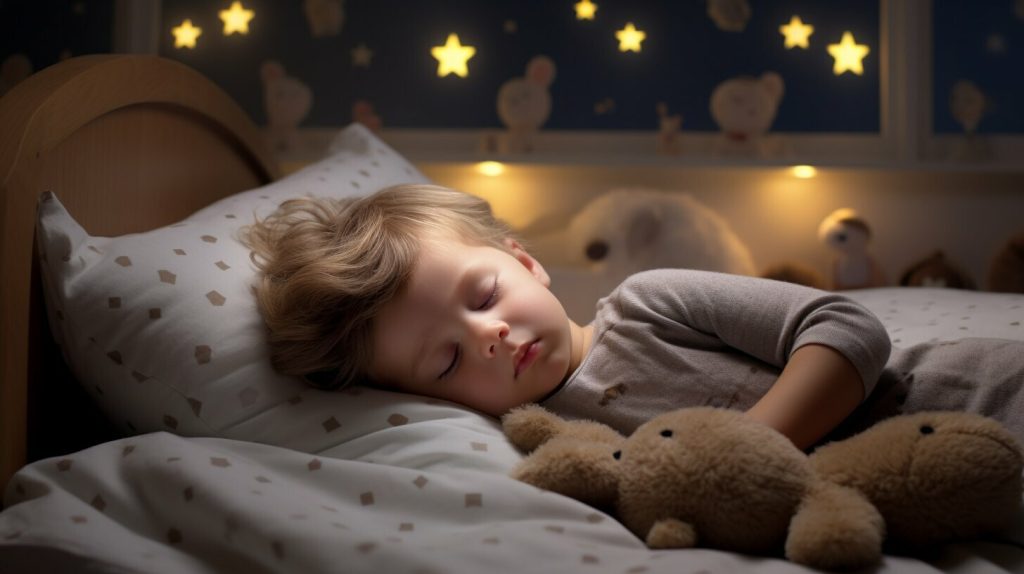
By following these guidelines and considering the individual readiness of your child, you can make an informed decision about when to introduce a pillow into their sleep routine. Remember, each child is unique, and their safety should always come first.
NHS Guidelines for Pillow Usage
The NHS provides valuable guidance on when it is safe for a child to start using a pillow, taking into account the potential risks and concerns.
According to the NHS, babies are not recommended to sleep with a pillow until they are at least 12 months old. Some groups suggest waiting until they are 18 months old, while others say to wait until they are two years old.
It is generally advisable to wait until the child has become a toddler and has moved from a cot to a toddler bed, usually around 18 months to two years of age.
The reason for avoiding pillows before this age is the risk of suffocation and sudden infant death syndrome (SIDS). Soft objects like pillows can block a baby’s airway or cause overheating.
The NHS recommends safe sleep habits, such as placing babies on their back to sleep, using a firm and flat mattress with a fitted sheet, and avoiding pillows, duvets, cushions, bedding rolls, or soft toys in a baby’s bed.
When a child is ready for a pillow, it is important to choose a toddler pillow specifically made for their age.
Adult-sized pillows are too big and can pose a suffocation risk. A suitable toddler pillow should be thin, firm, and small, allowing the child to move out from under it if necessary easily.
Choosing a hypoallergenic pillow may also be beneficial if the child has allergies or sensitive skin.
It is advisable to follow the guidelines and wait until a child has become a toddler before introducing a pillow into their bed.
Each child is different, and if both the child and parent are comfortable with the child sleeping without a pillow, there is no rush to introduce one. Safety should always be the top priority when considering a child’s sleep environment.
Recommended Age for Introducing a Pillow
Determining the best age to introduce a pillow to a child’s sleep routine can vary, but it is important to consider factors that promote their comfort and sleep quality.
As previously mentioned, The NHS advises against introducing pillows to babies until they are at least 12 months old to reduce the risk of suffocation and SIDS.
However, some experts suggest waiting until the child is 18 months to two years old and has transitioned to a toddler bed.
Before introducing a pillow, ensuring it is suitable for the child’s age is crucial. Adult-sized pillows are inappropriate as they can pose a suffocation risk and hinder their ability to move freely. Instead, opt for a toddler pillow that is thin, firm, and proportionate to their size.
When selecting a toddler pillow, consider your child’s individual needs. If they have allergies or sensitive skin, choose a hypoallergenic pillow to minimise discomfort.
Additionally, prioritise safety by avoiding pillows with loose fibres or excessive padding that could present choking hazards.
Factors to Consider when Introducing a Pillow:
| Factors | Considerations |
|---|---|
| Age | Wait until the child is at least 12 months old and has transitioned to a toddler bed. |
| Pillow Size | Choose a toddler pillow that is thin, firm, and proportionate to the child’s size. |
| Pillow Material | Consider hypoallergenic pillows for children with allergies or sensitive skin. |
| Safety | Avoid pillows with loose fibers or excessive padding that could pose choking hazards. |
It is crucial to prioritise safety and the child’s individual readiness when introducing a pillow. If both the child and parent are comfortable with the child sleeping without a pillow, there is no rush to introduce one.
Always consult healthcare professionals for specific guidance based on your child’s unique circumstances and needs.
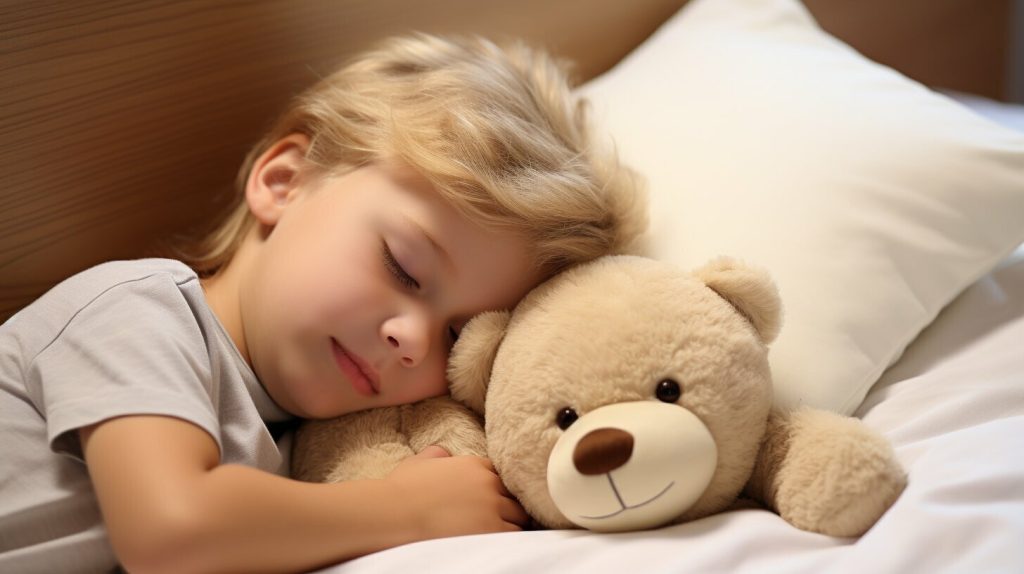
Risks of Pillows for Babies
Using a pillow too early for a baby can pose serious risks, such as suffocation and SIDS, making it crucial to understand the potential dangers.
The soft and plush nature of pillows can be hazardous for babies, as they can accidentally cover their nose and mouth, leading to suffocation. Additionally, pillows can cause overheating and increase the risk of SIDS.
The American Academy of Pediatrics (AAP) recommends keeping the baby’s sleep environment free from pillows, blankets, crib bumpers, and other soft bedding until at least one year of age.
According to the NHS, a safe sleep environment for babies involves placing them on their back to sleep on a firm, flat mattress with a fitted sheet. It is important to avoid using pillows, duvets, cushions, bedding rolls, or soft toys in their crib or cot.
By following these guidelines, parents can help reduce the risk of SIDS and create a safer sleeping environment for their baby.
| Safe Sleep Practices for Babies: |
|---|
| Place babies on their back to sleep |
| Use a firm and flat mattress with a fitted sheet |
| Avoid using pillows, duvets, or cushions in the crib or cot |
| Keep the baby’s sleep area free from soft toys and loose bedding |
Once they have reached the appropriate age and have transitioned to a toddler bed, you can consider introducing a suitable pillow that adheres to safety guidelines for their age group.
Transitioning to a Toddler Bed
Moving from a cot to a toddler bed often indicates that a child is reaching an age where they may be ready to transition to using a pillow for sleep.
This milestone is a significant step in a child’s development and can signal their increasing independence and readiness to adopt new sleeping habits.
| Key Considerations for Choosing a Suitable Toddler Pillow | |
|---|---|
| Size: | Choose a pillow that is proportionate to the child’s head and neck size. |
| Firmness: | A firm pillow provides adequate support for the child’s developing neck and spine. |
| Hypoallergenic: | If the child has allergies or sensitive skin, consider a hypoallergenic pillow to minimise potential discomfort. |
It is important to note that each child is different, and parental comfort should be considered when deciding when to introduce a pillow.
If both the child and parent are comfortable with the child sleeping without a pillow, there is no rush to introduce one. Safety should always be the top priority when considering a child’s sleep environment.

Remember, the decision to introduce a pillow should be based on the child’s individual readiness and safety considerations. Consulting with a healthcare professional can provide further guidance and ensure that the transition to using a pillow is done at the appropriate time for your child.
Choosing a Suitable Toddler Pillow
When choosing a suitable pillow for a child, ensuring the right size, firmness, and potential allergen-free options are crucial for their safety and comfort.
Toddler pillows are designed to provide adequate support while minimising the risk of suffocation or discomfort.
Size is an important consideration when selecting a toddler pillow. It should be small enough to fit the child’s head and neck properly, allowing for the correct alignment of the spine.
A pillow that is too large can cause strain on the neck and shoulders, leading to discomfort and disrupted sleep.
Firmness is another key factor to consider. A toddler pillow should be firm enough to provide support but still soft and comfortable for the child. It should not collapse under the weight of the head, ensuring proper spinal alignment during sleep.
Choosing a hypoallergenic pillow is recommended for children with allergies or sensitive skin.
These pillows are designed to minimise the risk of allergic reactions using materials that repel dust mites, mould, and other common allergens.
Parents can choose a suitable toddler pillow that promotes safe and comfortable sleep for their child by carefully considering the size, firmness, and allergen-free options.

Individual Variations and Parental Comfort
While there are general guidelines, it is essential to remember that each child’s readiness for a pillow can vary, and parents’ comfort levels should also be considered.
Some children may be interested in using a pillow earlier than others, while some parents may feel more comfortable introducing a pillow at a younger age. It is important to assess the individual circumstances of the child and the family when making this decision.
One factor to consider is the child’s ability to adjust to changes in their sleep routine. If a child has successfully transitioned from a cot to a toddler bed and is comfortable in their new sleeping environment, it may be a good time to introduce a pillow.
However, if a child is still adjusting to a new bed or experiencing sleep disturbances, it may be best to wait until they are more settled before introducing a pillow.
Parents’ comfort is also an important consideration. If a parent feels anxious or concerned about their child using a pillow, waiting until they are more comfortable with the idea is perfectly acceptable.
Parents know their children best and should trust their instincts regarding their child’s sleep habits.
| Factors to Consider | Timing |
|---|---|
| Child’s age and readiness | Assess individual circumstances |
| Transition to a toddler bed | Wait until the child is settled |
| Parental comfort | Trust instincts and wait until ready |
Introducing a pillow should always prioritise safety. Choosing a suitable toddler pillow appropriate for the child’s age and size is important.
By following the recommended guidelines and considering individual circumstances, parents can make an informed decision about when to introduce a pillow to their child’s sleep routine.
Ensuring Safety Always Comes First
Above all, ensuring a child’s sleep safety should be the foremost consideration, and introducing a pillow should align with established safe sleep practices.
According to child pillow safety guidelines, waiting until a child has transitioned to a toddler bed before introducing a pillow is advisable. This usually occurs around 18 months to two years of age.
Soft objects like pillows can pose a suffocation risk for babies and increase the likelihood of sudden infant death syndrome (SIDS).
To create a safe sleep environment, the NHS recommends placing babies on their backs to sleep, using a firm and flat mattress with a fitted sheet, and avoiding pillows, duvets, cushions, bedding rolls, or soft toys in a baby’s bed.
These measures help to reduce the risk of accidental suffocation or overheating.
When selecting a pillow for a child, choosing one specifically designed for their age is crucial. Adult-sized pillows are too large, increasing the risk of suffocation. Opt for a thin, firm, and small-sized toddler pillow that allows the child to move easily and freely.
Additionally, if the child has allergies or sensitive skin, consider a hypoallergenic pillow to prevent any potential discomfort or reactions.
Introducing a pillow should be based on the child’s readiness and parental comfort. If both the child and parent are comfortable with the child sleeping without a pillow, there is no rush to introduce one.
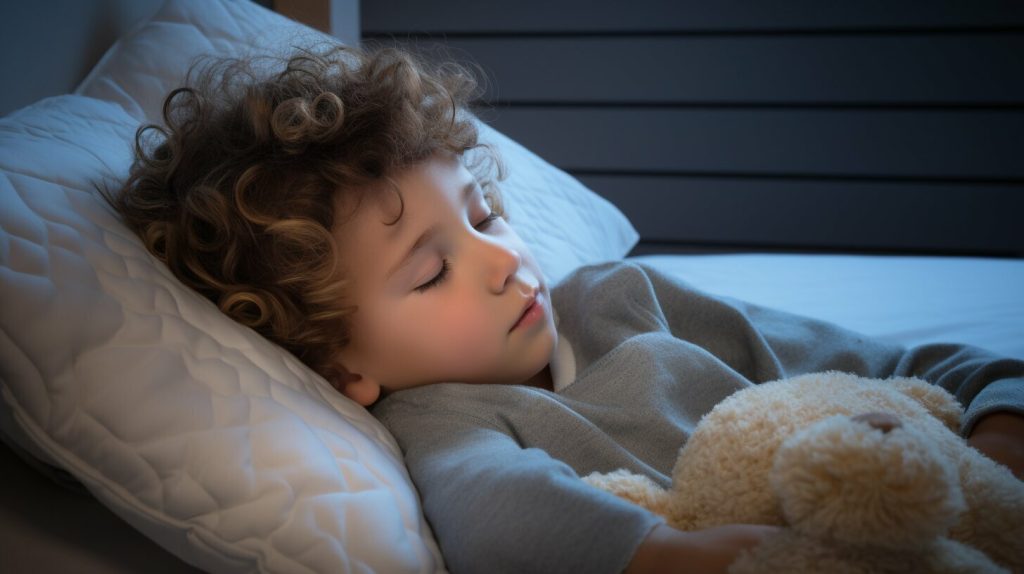
Considering Individual Circumstances
It is crucial to consider any unique circumstances that may affect a child’s need for a pillow, such as medical conditions or other specific needs.
While the recommended age for introducing a pillow is typically around 18 months to two years, some children may require one earlier due to certain medical conditions or physical abnormalities.
Consulting with a paediatrician or healthcare professional is essential to ensure the child’s safety and comfort.
Children with conditions such as acid reflux or chronic respiratory issues may sometimes benefit from sleeping with a slight incline provided by a pillow.
However, it is important to consider the specific recommendations of healthcare professionals and the child’s needs and comfort level.
Close monitoring of the child’s sleep habits and regular communication with medical experts will help determine whether introducing a pillow is appropriate or if alternative solutions should be considered.
Children with certain musculoskeletal conditions may also require additional support and comfort during sleep. Conditions such as scoliosis or other spine-related issues may benefit from specialised orthopaedic pillows or positioning aids.
In these cases, it is crucial to consult with a healthcare professional or specialist who can guide the best pillow options to accommodate the child’s condition and ensure their well-being.
| Unique Circumstance | Pillow Considerations |
|---|---|
| Medical conditions affecting breathing | Consultation with healthcare professional; consider using a pillow to assist with breathing |
| Acid reflux or respiratory issues | Consultation with healthcare professional; consider using a pillow to provide slight incline |
| Musculoskeletal conditions | Consultation with healthcare professional or specialist; consider specialised orthopedic pillows or positioning aids |
It is important to remember that every child is unique. While general guidelines suggest a certain age for introducing a pillow, evaluating individual circumstances is vital.
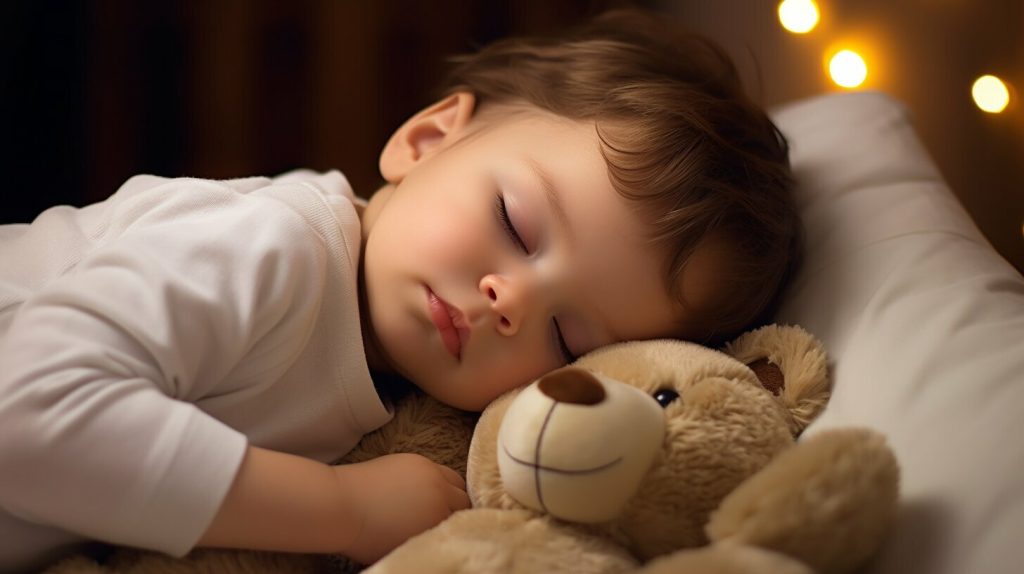
Conclusion
Understanding when a child should sleep with a pillow requires careful consideration of safety, individual readiness, and the guidelines experts provide.
According to the NHS, waiting until a child is at least 12 months old is generally recommended before introducing a pillow.
Some groups suggest waiting until 18 months or even two years old. The key factor is when a child has transitioned from a cot to a toddler bed, typically between 18 months and two years of age.
The reason for waiting is to minimise the risk of suffocation and sudden infant death syndrome (SIDS). Soft objects like pillows can obstruct a baby’s airway or cause overheating.
The NHS emphasises safe sleep habits, such as placing babies on their back to sleep, using a firm and flat mattress with a fitted sheet, and avoiding pillows, duvets, cushions, bedding rolls, or soft toys in a baby’s bed.
When a child is ready for a pillow, choosing a toddler pillow designed for their age is crucial.
Adult-sized pillows are too large and can pose a suffocation risk. A suitable toddler pillow should be thin, firm, and small, allowing the child to move out from under it if needed.
Additionally, a hypoallergenic pillow can be beneficial if the child has allergies or sensitive skin.
Ultimately, adhering to the guidelines is recommended and waiting until a child has transitioned to a toddler bed before introducing a pillow.
However, it’s important to note that each child is unique, and if both the child and parent are comfortable with the child sleeping without a pillow, there is no rush to introduce one.
In any case, prioritising safety should always be the foremost consideration when deciding a child’s sleep environment.
FAQs
Q: When should a child sleep with a pillow?
A: According to the NHS, waiting until a child is at least 12 months old is recommended before introducing a pillow. Some groups suggest waiting until they are 18 months or two years old.
Q: Why should pillows be avoided for babies?
A: Pillows pose a risk of suffocation and sudden infant death syndrome (SIDS) for babies. Soft objects like pillows can block a baby’s airway or cause overheating.
Q: What are the recommended safe sleep habits for babies?
A: The NHS advises placing babies on their back to sleep, using a firm and flat mattress with a fitted sheet, and avoiding pillows, duvets, cushions, bedding rolls, or soft toys in a baby’s bed.
Q: When is a child ready for a pillow?
A: It is generally recommended to wait until a child has become a toddler and has transitioned from a cot to a toddler bed, which usually happens around 18 months to two years of age.
Q: What should I consider when choosing a toddler pillow?
A: It is important to select a thin, firm, and small pillow specifically made for toddlers. Avoid adult-sized pillows, as they can pose a suffocation risk. Hypoallergenic options may be beneficial for children with allergies or sensitive skin.
Q: Is there a rush to introduce a pillow to a child’s sleep routine?
A: Each child is different, and if both the child and parent are comfortable with the child sleeping without a pillow, there is no rush to introduce one. Safety should always be the top priority.
Q: What should I prioritize when considering a child’s sleep environment?
A: Safety should always come first. It is important to follow the guidelines and wait until a child has become a toddler before introducing a pillow.
Safe sleep practices should be followed, such as a suitable mattress and avoiding soft objects in the bed.
Q: Can individual circumstances affect the decision to introduce a pillow?
A: Yes, circumstances like medical conditions or other factors may impact the decision to introduce a pillow. It is important to consider any specific needs or concerns when making the decision.
